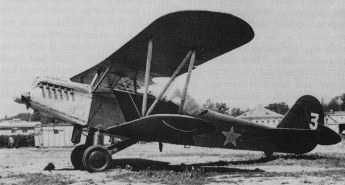
R-5s in flight. Photo Credit: Wings of Russia
In June of 1941, at the time of the German invasion of the Soviet Union, the VVS had only recently begun its modernization campaign to produce aircraft that were on par with their Axis counterparts. Fighters such as the I-16 Rata that had been mainstays in the Spanish Civil War, Khalkin Gol, and the Winter War, were slowly being replaced by the LaGG-3 and Yak-1; aircraft which VVS pilots quickly found to be inferior to the Luftwaffe’s Bf-109. In terms of numbers of aircraft prior to Operation Barbarossa, however, the Soviet Union had a clear advantage over Germany, though most of these machines were considered to be out-of-date by the outbreak of war. Indeed, some Soviet aircraft that had seen service throughout the 1930s, such as the Polikarpov R-5 biplane, had been scattered throughout the Soviet interior at the end of the decade, ending up in various flying schools, aero clubs, and different transportation detachments. In the summer of 1941, however, the VVS found its mighty air fleet decimated by the German blitzkrieg, and seemingly out-of-date aircraft, such as the R-5, were brought to the front to serve as night bombers and liaison aircraft until Soviet industry could recover from the invasion and begin manufacturing large numbers of modern aircraft. The Soviet military, with its knack for getting the most out of ostensibly obsolete equipment, was able to find a useful role for the antiquated R-5 biplane.
The R-5, powered by a Mikulin M-17B water cooled V-12 engine that put out 680 horsepower, was designed by Nikolai Polikarpov in 1928 and put in service by the VVS in 1931. It was used in Khalkin Gol, the Winter War, and the Soviet invasion of Poland, after which it was used primarily as a trainer until the summer of 1941, when several hundred returned to frontline duty. As Sergey Glumov, an R-5 pilot, recalled, “before the war it was a good airplane. But by 1941, it had, for technical reasons, become a completely ‘disliked’ aircraft… [only] four bombs… and about the speed, I cannot say without bringing tears to my eyes… There was no radio on the R-5. There was no lighting in the R-5 to view a map… the defenses were terrible… German tracer shells mowed down our planes.”

R-5. Photo Credit: Pacific Eagles
Nonetheless, the fall of 1941, due to the lack of modern aircraft, R-5s were assigned to the 615th and 687th regiments during the defense of Moscow, where the biplanes carried out an estimated 10% of all night bombing sorties. Similar to the more well-known Polikarpov Po-2, the R-5 engaged in primarily night bombing and reconnaissance missions. In January of 1942, night bomber regiments equipped with R-5s were tasked with providing support for the 2nd Shock Army near Lake Ladoga in an attempt to break the siege of Leningrad. Primarily engaged in operations to disrupt rail transport and conduct reconnaissance, the number of regiments flying R-5s on the Volkhov Front continued to increase, and the antiquated biplanes found a new role: delivering rations and ammunition and evacuating the wounded from the front. In March and April, when elements of the 13th Calvary Corp of the 2nd Shock Army were surrounded by Wehrmacht forces, the 658th air regiment delivered more than one thousand tons of food, ammunition, and other supplies, and evacuated 676 wounded soldiers and officers.

Photo Credit: Combat Ace
Soviet R-5s continued to play the above-mentioned roles not only near Leningrad, but also in the Southwestern Front, the Bryansk Front, and the Southern Front. It was only in mid-1943, when the Soviet aviation industry had recovered from the wholesale evacuation eastward in 1941-1942, that the biplanes began to be phased out. La-5s, Yak-9s, Il-2s, and Pe-2s began arriving at the front in large numbers, and R-5s were once again relegated primarily to training roles. Nevertheless, the Polikarpov biplanes continued to be used in specialized roles along the Eastern Front, and were often used for delivering supplies to Soviet partisans behind enemy lines. R-5s continued in such specialized roles through the end of the war, and some were even as far west as Berlin in May of 1945.
The scant amount of historical coverage in the West given to the air war on the Eastern Front focuses primarily on lend-lease aircraft such as the P-39, P-40, and Spitfires, and on the capable Soviet-built Lavochkins, Yakovlevs, and Ilyushins that came out later in the war, all of which undoubtedly played a crucial role in the Soviet Union’s victory over Germany. However, before such aircraft were available in large numbers, seemingly obsolete biplanes, such as the Polikarpov R-5, were thrown into battle after having been relegated to training roles several years before the outbreak of World War Two. The R-5 is indicative of a larger trend throughout all facets of the Soviet military, in which equipment that was ostensibly outdated and outmatched by the German military machine enabled the Soviet Union to proverbially bend but not break in the early stages of the war, until modern machinery could be given to Soviet soldiers, airmen, and sailors. This, in turn, enabled the Red Army to push back the Wehrmacht all the way to Berlin. However, the equipment that brought the Soviet Union into the crucial year of 1943, such as the R-5, played a large role in the victory over Germany, and deserves to be remembered as such.
-Patrick Kinville